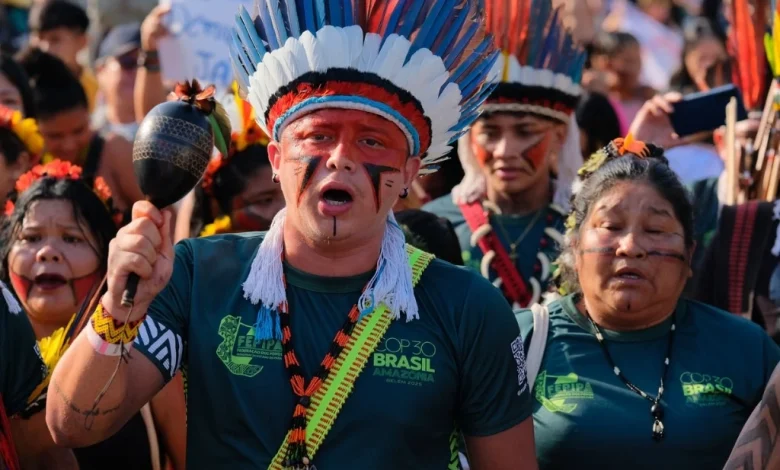Brazil to Recognize 10 Indigenous Lands Following COP30 Protest

After last Friday’s Munduruku people’s protest at COP30, the Brazilian government had already promised to move forward with the process of two indigenous lands – one of them is on the list released today.
—
On Monday, Brazil’s Minister of Indigenous Peoples Sonia Guajajara announced that declaratory ordinances will be issued for 10 new Indigenous lands. The administrative acts formally recognizing the territories as Indigenous Lands and advancing their demarcation processes should be published “at any moment” in the Official Gazette, according to the minister.
Declaratory ordinances are one of the last formal steps in the process to demarcate an Indigenous Land in Brazil. They recognize the perimeter of the area and establish the physical boundaries of the territory. After this phase, the land is officially approved and registered to be exclusively used by populations living there.
UN Secretary-General António Guterres and Brazilian President Luiz Inácio Lula da Silva attend Thematic Session 1: Climate and Nature. Photo: UN Climate Change/Kiara Worth via Flickr.
Last week, the Brazilian government had already announced that it would move forward with the demarcation of two Indigenous Lands belonging to the Munduruku people. One of them – the Sawré Ba’pim – appears on the list released this Monday with territories to be declared. With this list, the number of indigenous territories whose demarcation processes have advanced that were announced by Brazil’s government during the climate conference in Belém should rise to 11.
Another Indigenous Land – the Sawré Muybu, in the Tapajós basin – already has its declaratory ordinance. Last week, an announcement was made that it will advance towards physical demarcation, but the next step – official recognition – has yet to come.
List of the 10 new Indigenous lands (click to view)
- Vista Alegre Indigenous Land (Amazonas state – Mura Indigenous People)
- Tupinambá de Olivença Indigenous Land (Bahia state – Tupinambá Indigenous People)
- Comexatiba Indigenous Land (Bahia state – Pataxó Indigenous People)
- Ypoi Triunfo Indigenous Land (Mato Grosso do Sul state – Guarani Indigenous People)
- Sawre Ba’pim Indigenous Land (Pará state – Munduruku Indigenous People)
- Pankará da Serra do Arapuá Indigenous Land (Pernambuco state – Pankara Indigenous People)
- Sambaqui Indigenous Land (Paraná state – Guarani Indigenous People)
- Ka’aguy Hovy Indigenous Land (São Paulo state – Guarani Indigenous People)
- Pakurity Indigenous Land (São Paulo state – Guarani Indigenous People)
- Ka’aguy Mirim Indigenous Land (São Paulo state – Guarani Indigenous People)
The announcement of the 10 new Indigenous Lands was made at a high-level meeting of the conference in order to turn heads of states’ political promises into concrete actions to guarantee territorial rights. Ministers from several countries and philanthropic leaders participated and signed land protection commitments, recognizing Indigenous peoples and traditional communities as essential guardians of the forests and central actors in the climate agenda.
According to Indigenous leaders present at the event, the package of ordinances meets a historical demand for territories to finally be recognized as part of the climate solution, given the proven role of Indigenous lands in containing deforestation and preserving the Amazon.
During the ceremony, Sonia Guajajara also signed a commitment to allocate an additional 59 million hectares of public land to Indigenous peoples to implement Brazil’s National Policy for Territorial and Environmental Management of Indigenous Lands and to consolidate land tenure after the removal of non-Indigenous occupants. According to the ministry, this measure underscores Brazil’s alignment with international mechanisms for climate protection and human rights.
More on the topic: Why COP30 Needs Indigenous Voices
Munduruku indigenous people hold a demonstration. Photo: UN Climate Change/Diego Herculano via Flickr.
Last week, Indigenous people held peaceful demonstrations at the entrance to COP3’s Blue Zone in Belém. On Saturday, thousands of representatives of traditional peoples and civil society organizations took to the streets of the capital of Pará in the Global Climate March. The main demands included recognition of traditional territories.
Featured image: UN Climate Change/Diego Herculano via Flickr.
—
This story was originally produced by InfoAmazonia through the Socio-environmental Collaborative Coverage of COP30, and published with edits by Earth.Org. Read the original story here.
Follow our COP30 coverage.





